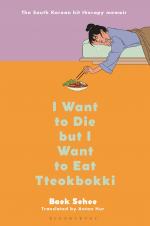|
This section contains 524 words (approx. 2 pages at 400 words per page) |

|
I Want to Die But I Want to Eat Tteokbokki Summary & Study Guide Description
I Want to Die But I Want to Eat Tteokbokki Summary & Study Guide includes comprehensive information and analysis to help you understand the book. This study guide contains the following sections:
This detailed literature summary also contains Topics for Discussion on I Want to Die But I Want to Eat Tteokbokki by Baek Sehee.
The following version of this book was used to create the guide: Baek, Sehee. I Want to Die but I Want to Eat Tteokbokki. Bloomsbury, 2022.
I Want to Die but I Want to Eat Tteobokki is a memoir by Baek Sehee (in Korean naming convention, the last name comes before the first name. Baek Sehee refers to herself in the book by her given name, Sehee), originally published in Korean in 2018 before being translated into English in 2022 by Anton Hur. The memoir covers a period in Sehee’s life in which she was suffering from depression and takes the form of a mixture of recorded dialogues between Sehee and her psychiatrist, as well as Sehee’s musings on her mental state and life in general.
When the book opens, Sehee has been suffering from varying levels of depression for her entire life, though it became bad enough by the opening of the book for Sehee to make a consultation with a psychiatrist. In these psychiatrist sessions, Sehee and the psychiatrist unpack the various details and traumas of Sehee’s life. Sehee is initially diagnosed with dysthymia, persistent mild levels of depression, though the psychiatrist notes that Sehee also demonstrates symptoms of other mental disorders, including Histrionic Personality Disorder and Attention Deficit Disorder.
Sehee recalls her turbulent and unstable home life. The family was working class, and Sehee felt embarrassed about this often. Her father was physically abusive toward her mother, as well as toward Sehee and her sisters. Sehee was raised in many ways by her older sister, who was withholding of affection and emotionally manipulative to Sehee. Sehee’s parents and her older sister would make Sehee feel that she was never good enough, which manifests in her adult life as low self-esteem.
Sehee is shown to worry deeply about what others think of her and feels entrapped by societal beauty standards. She finds it hard to maintain relationships, both in terms of friendships and romantic relationship. Through stories of Sehee’s friends and her partners, the reader sees how Sehee has a tendency to become overly attached and then lash out when she perceives them as being critical toward her. Sehee’s low self-esteem causes her to not think any person could truly love her, so she mistrusts all love she receives. She also holds herself to an impossible standard and become upset when she does not meet her absurdly high expectations for herself.
The Psychiatrist puts Sehee on medication to help control her anxiety and depression and sleeping pills to combat her insomnia. Sehee mostly finds them helpful, although she experiences many negative side effects and laments the fact that it takes so long for her body to adjust to the medication. She also makes several positive changes in her life, including leaving her high stress job, cutting back alcohol, exercising more, and spending more time alone. At the end of the book, Sehee notes that while she has not yet, and might never, be in a state without mental health issues, but she has made significant improvements and hopes to one day be open to love and happiness.
Read more from the Study Guide
|
This section contains 524 words (approx. 2 pages at 400 words per page) |

|



